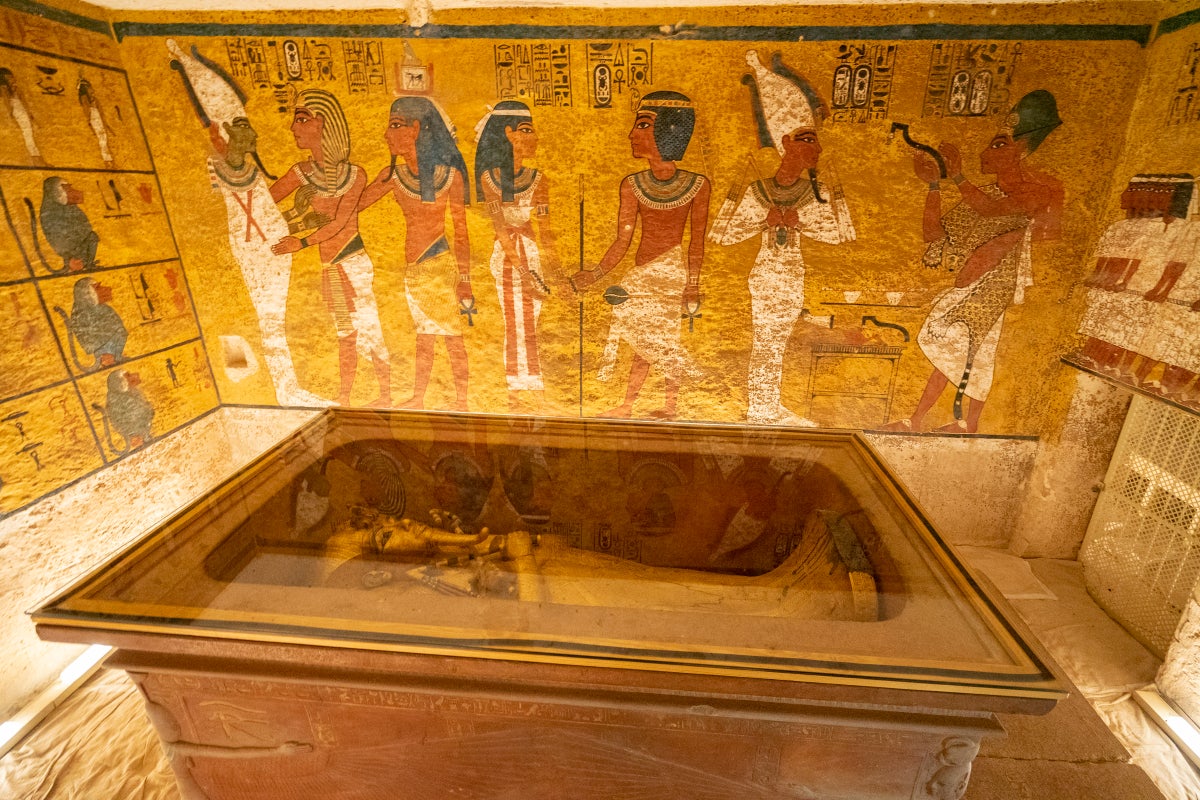
This article first appeared on our partner site, Independent Arabia
The tomb of Tutankhamun in Luxor is in its most fragile state since its discovery in 1922 with cracks spreading across ceilings, rock layers peeling under humidity, and mural colours fading under the assault of fungi.
The tomb, one of the smallest royal burials in the Valley of the Kings, is suffering from a major fracture running across the ceiling of the burial chamber and entrance, causing fissures that have allowed rainwater to seep inside.
Given the nature of the Esna shale rock used in the tomb, which expands and contracts with changes in humidity, the risk of deformation and collapse now looms over both the structure and its intricate decorations.
West of Luxor, the Valley of the Kings is home to dozens of royal tombs carved deep into the mountains. Many of these have been eroded by sudden flash floods that periodically strike the area. In 1994, a catastrophic deluge submerged the valley in silt-laden water that eroded the rock layers and led to a sharp rise in humidity levels within the tombs.
As a result, fungi flourished and damaged precious paintings and murals, while the valley’s fragile geological makeup, dominated by weak Esna shale, further compounded the crisis.
In a recent study published in Nature’s npj Heritage Science journal, Sayed Hemeda, Professor of Preservation of Architectural Heritage at Cairo University, notes that Tutankhamun’s tomb is now suffering from compromised structural integrity. He identified the 1994 flood as the turning point: it allowed water ingress, raised humidity levels and triggered fungal growth that ravaged the wall paintings.
Dr Hemeda also highlighted that the major fissure cutting across the ceilings of both the burial chamber and the entrance had “allowed rainwater to penetrate and worsened the cracks, placing the ceiling under pressures exceeding the capacity of Esna shale rock to withstand, particularly given its tendency to expand and contract with fluctuations in humidity”.
The study concluded with a recommendation to “minimise humidity fluctuations to preserve the tomb by regulating its internal environment and implementing a focused programme of reinforcement and conservation”.
Known by the standard designation KV62 among Egyptologists, Tutankhamun’s tomb remains one of the most significant archaeological finds of the 20th century. It was discovered by British archaeologist Howard Carter on the 4th of November 1922, after years of excavation, hidden behind a modest entrance buried among the debris of other tombs.
The tomb, smaller-than-usual royal tombs of the 18th Dynasty, is believed not to have been originally designed as a royal burial place, but rather hastily repurposed following the young pharaoh’s sudden death.
Tutankhamun’s tomb consists of four main chambers: the entrance; the antechamber where furniture and chariots were found; the burial chamber holding three nested coffins; and the treasury, which once housed some 5,000 artefacts, including the famed golden mask, gilded statues, fine furniture, weapons and funerary objects, reflecting the complex rituals associated with royal burials.
Mohamed Atia Hawash, Professor of Architectural Conservation at Cairo University’s Faculty of Archaeology, explains that most tombs in the Valley of the Kings are cut deep into the rock, making them vulnerable to periodic flash floods that create cavities and sometimes fill with water which damages the wall paintings.
He warns that the surrounding mountains themselves suffer from extensive fissures, not only in the valley but also in the Deir el-Bahari area where the mortuary temple of Queen Hatshepsut is located. These fractures pose the risk of large rock masses detaching and collapsing onto adjacent tombs.
Dr Hawash’s research stresses that Tutankhamun’s tomb is not the only site at risk, but it serves as a “stark warning that must be heeded”. He added that “a disaster could strike at any moment, and if the Valley of the Kings is to be preserved, action must be taken before it is too late.”
The area, though a part of the listed UNESCO World Heritage site of Ancient Thebes and its Necropolis, remains far from secure. This raises urgent questions about the absence of risk management plans and the inaction of responsible authorities in the face of such threats.
Professor Hawash points out that earlier studies have already warned of new fissures and the likelihood of further flash floods, but no real action has followed.
Speaking to Independent Arabia, he noted that crisis management structures exist but remain ineffective in practice: “We have the ability to monitor risks scientifically, but the absence of a culture of prevention means we only react after disaster strikes.”
He highlighted that Tutankhamun’s tomb itself showcases sophisticated ancient techniques in colouring and the production of artificial pigments, such as Egyptian blue and green, and argued that practical solutions are needed – such as reducing the load on the mountain above the tomb or installing removable internal supports that preserve the site’s character while preventing potential collapse.
Emad Mahdi, a member of the Egyptian Archaeologists’ Union, said: “A high-level expert committee should be formed immediately to analyse the site geologically and archaeologically, assess the impact on the wall inscriptions, develop a precise risk profile, and prepare an urgent report for the highest authorities to enable swift action to save it.”
“As an archaeologist, I am deeply saddened by the state of the tomb. This crisis requires practical solutions, such as establishing a specialised risk-monitoring body composed of academics who issue reliable reports and continuously oversee the safety of archaeological sites. Where are the regular reports tracking threatened sites and outlining intervention and protection measures?”
Translated by Dalia Mohamed; Reviewed by Tooba Khokhar and Celine Assaf
